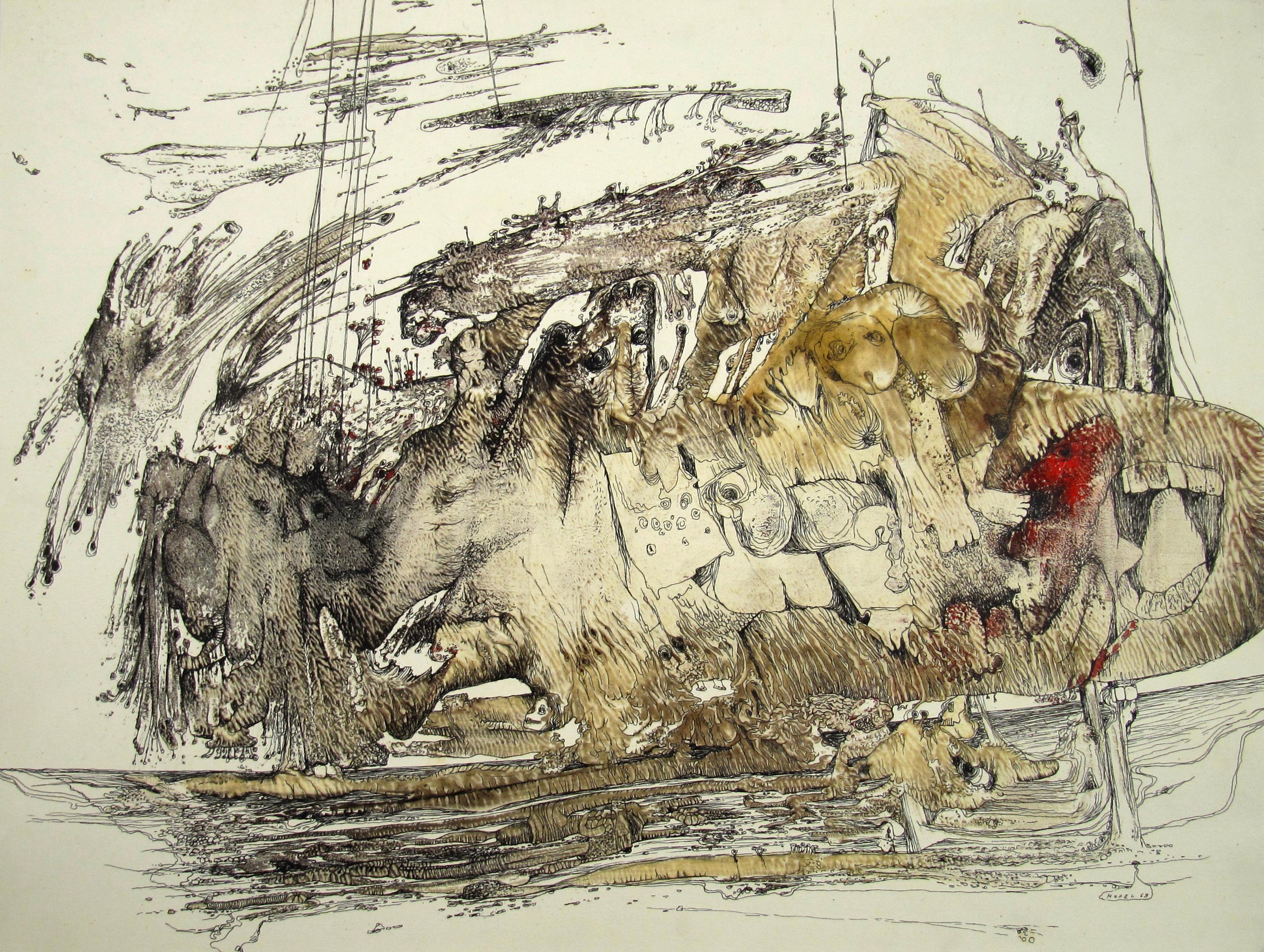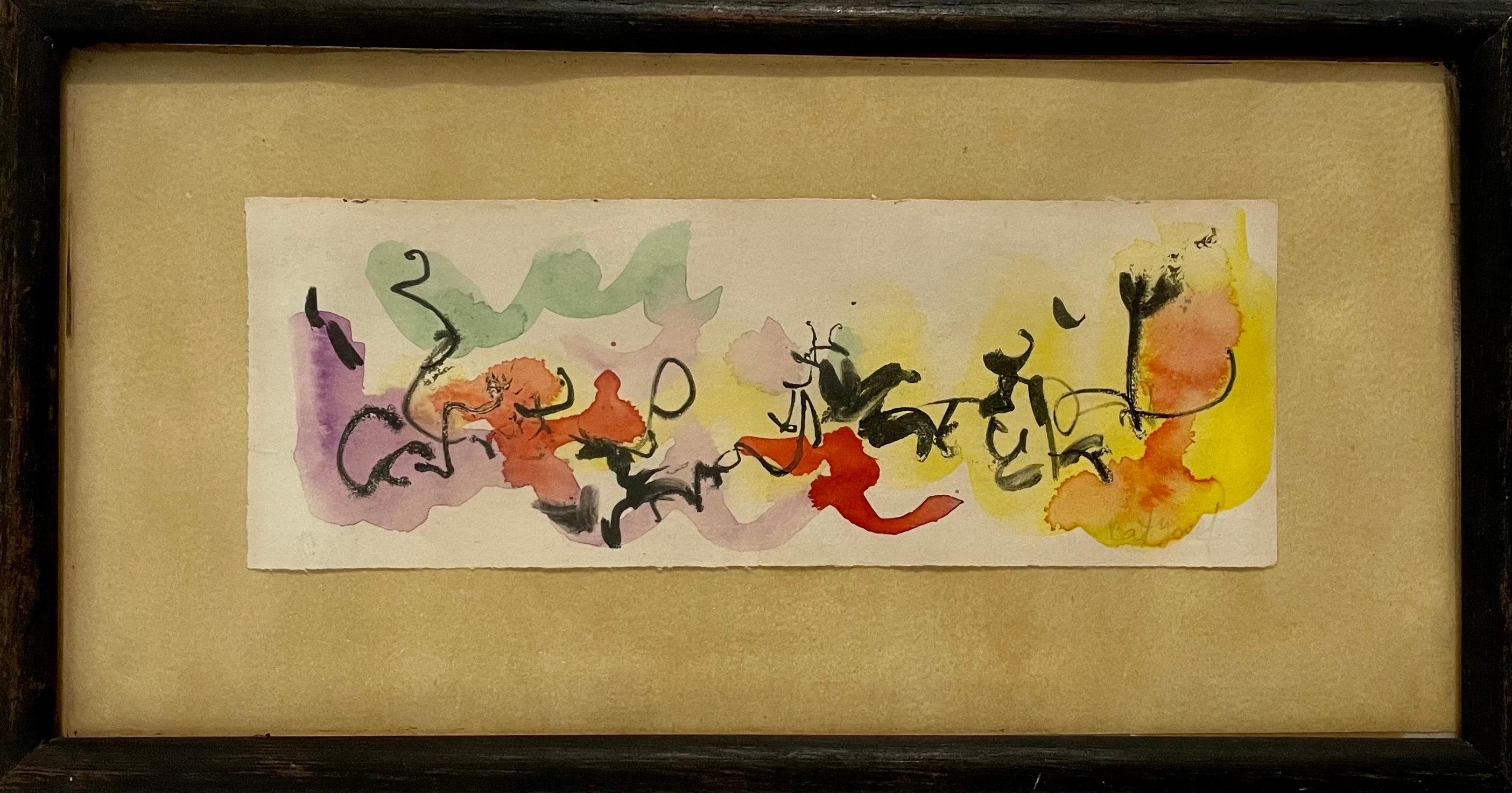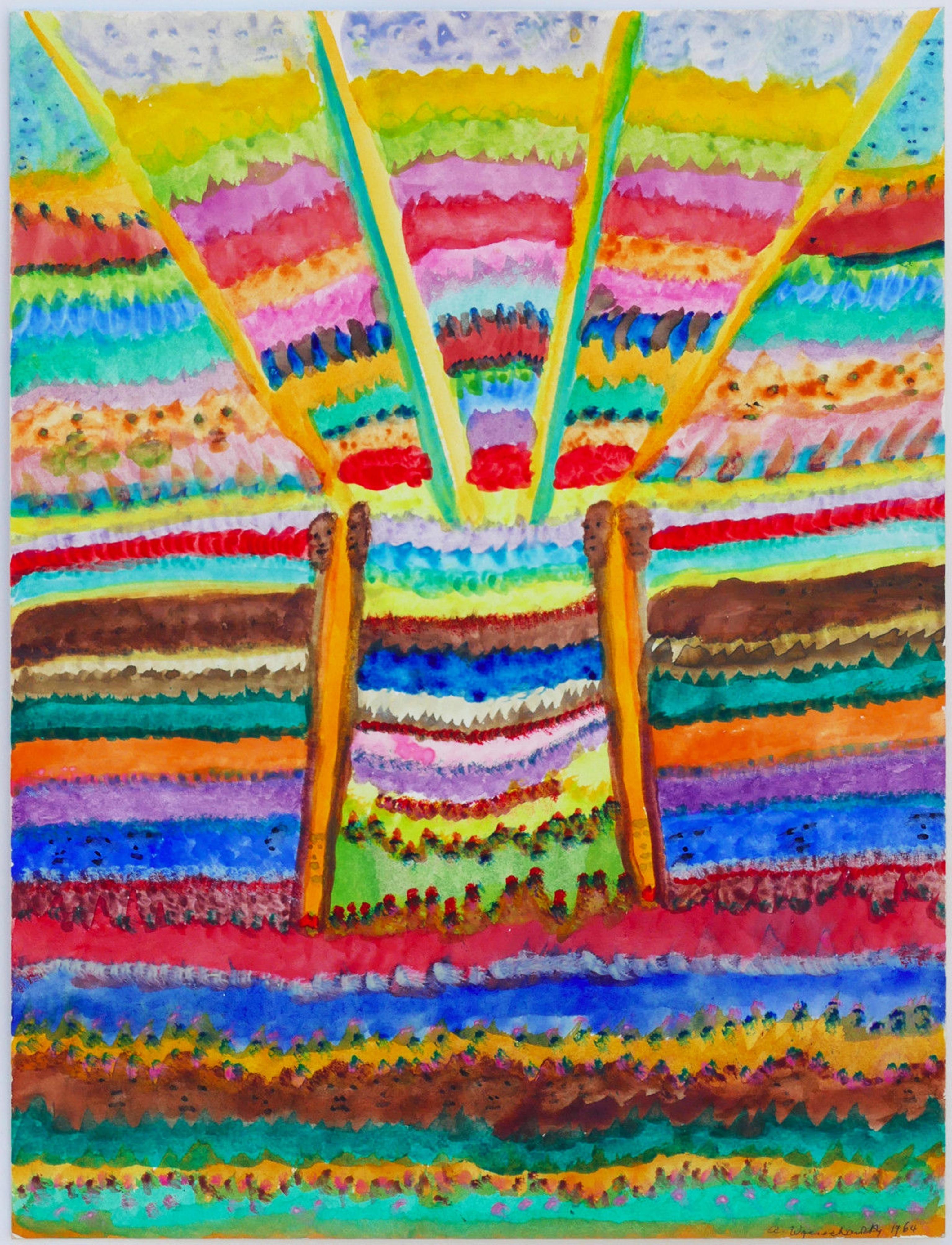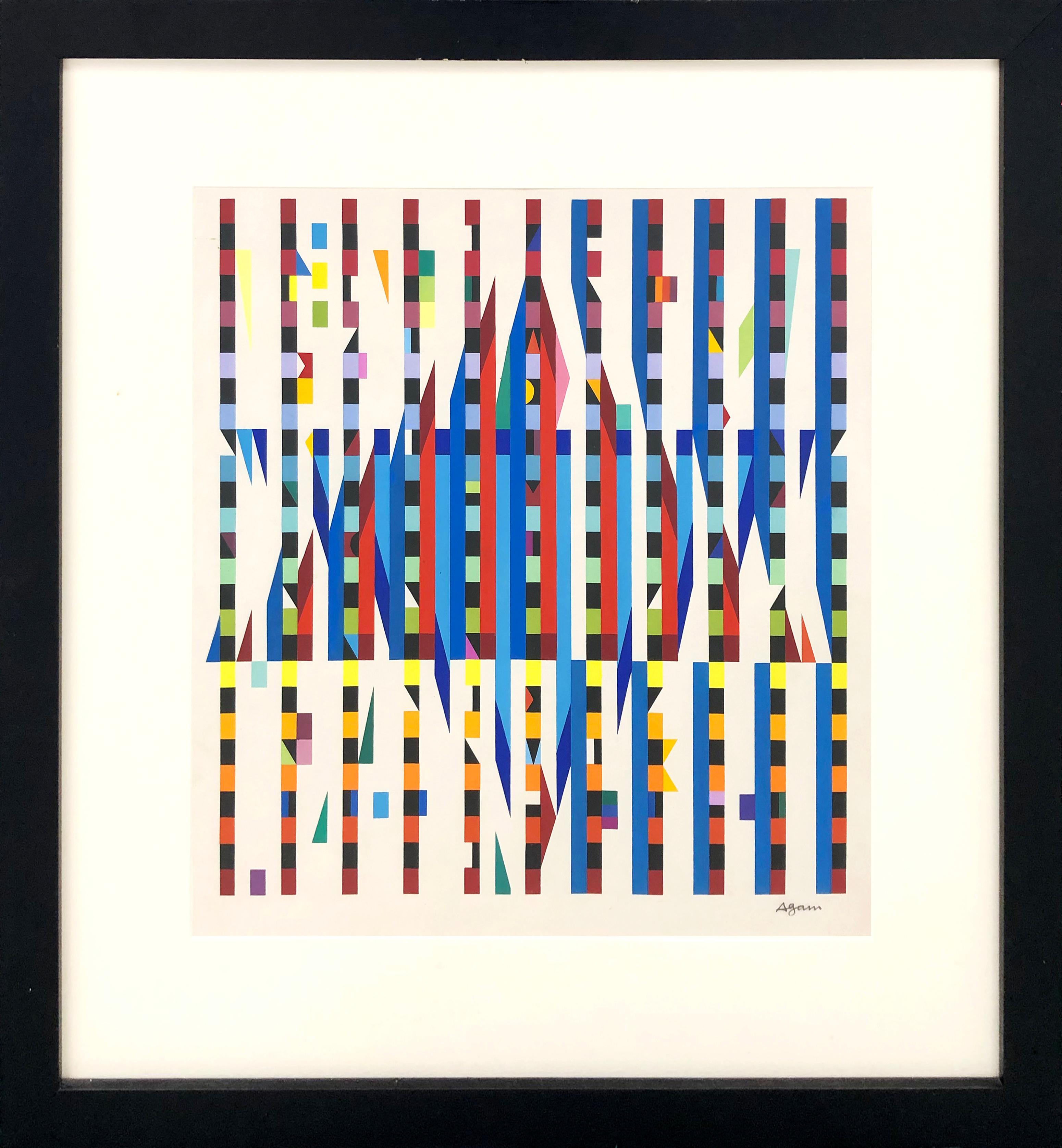Items Similar to "Study for Ladders" Juanita Guccione, Abstract Surrealism, Female Artist
Want more images or videos?
Request additional images or videos from the seller
1 of 8
Juanita Guccione"Study for Ladders" Juanita Guccione, Abstract Surrealism, Female Artist1948
1948
About the Item
Juanita Guccione (1904 - 1999)
Study for Ladders, 1948
Gouache on paper
17 x 13 inches
Signed lower left, dated, and inscribed “Study for Oil Painting #310” on the reverse
Juanita Guccione's life spanned all but four years of the 20th Century. Cubist, realist, surrealist, automatist and abstract strains are all to be found in her work, but by 1970 she was painting works in watercolor and acrylic that no longer included the human figure or the observed world. She was the younger sister of the abstract geometric artist Irene Rice Pereira. The sisters were born in Chelsea, MA, but spent most of their working lives in Manhattan.
In the early 1930s, Guccione, then painting as Nita Rice, lived for four years among the Ouled Nail Bedouin tribe in eastern Algeria. Her paintings from this period are devoid of the flamboyant romanticism of the Orientalist painters. She painted the Bedouin as friends and neighbors, reflecting the anti-colonialist attitude of her native land. These paintings were shown in The Brooklyn Museum in 1935.
When she returned from Algeria in 1935 the United States was in economic free-fall. After the Brooklyn Museum exhibit the Algerian work was shut away as she immersed herself in an avant-garde then fomenting revolutionary artistic changes. Guccione began painting as Anita Rice, changed her name to Juanita Rice, then to Juanita Marbrook, and finally to Juanita Guccione after marrying Dominick J. Guccione in the mid-1940s.
Guccione worked on Post Office murals for the WPA Federal Works Progress Administration during the 1930s. During World War II she came under the influence of the refugee French surrealists. She studied with Hans Hofmann for seven years. Hofmann expressed high regard for her work and gave her a number of scholarships. Her mid-career surrealist paintings do not share the literary interests of many of her European contemporaries. They portray a magical and whimsical world ruled by women. Their brilliant palette, though not their subject matter, reflects Hofmann's influence.
Guccione's work was shown in Manhattan, Paris, Beirut, Bombay, San Francisco, Washington, Provincetown, PalBeach, Pittsburgh, Miami, Algiers and other Algerian cities.
She was unusually reclusive, and this trait often thwarted enthusiasts attempting to promote and celebrate her work. Her reclusiveness, her name changes, and the critics' difficulty in characterizing her work deprived her of the recognition she might otherwise have received.
Nonetheless, the respected French novelist and critic Michel Georges-Michel wrote in the early 1950s that she was one of a very few American artists who interested him, this at a time when abstract expressionism was the rage and America was establishing its claim to importance in taste-making.
Describing her long career, the former Washington Post art critic Michael Welzenbach wrote in 1992: "This kind of artistic evolution hardly fits into the inimically popular contemporary trend of modifying one's style to keep abreast of fashionable changes in the mainstream art world. And it is precisely this single-minded approach to her work, this willingness to follow its development wherever that might lead, that locates Guccione squarely among the few but formidable ranks of the modernist avant-garde--a group whose integrity and vision will not be seen again in this century."
No one, probably not even Guccione, reckoned how prolific and restless her career had been until her works were collected after her death. Her reputation had come to rest on the surrealist oils of her middle years, while the more abstract and adventurous acrylic and watercolor work of her later years was little known.
The extraordinarily reticent artist hinted at her own view of her later work when she wrote to a purchaser that she did not imagine the work, she saw it.
Guccione was a respected teacher, perhaps because of her reticence. She was able to impart ideas and techniques by guiding her students' hands and by working alongside them, rather than lecturing them. She taught at the Art Students League and at Cooper Union.
The large body of work she left poses a special challenge to feminists because she created in her middle years a peaceable otherworld ruled entirely by women. Of feminists she was fond of remarking, "I'm not at all interested in what they say, only in what they do."
The French writer and poet Anais Nin, whose portrait Guccione painted several times, said of her work, "Our dreams are often diffuse and fragmented. Juanita makes them cohesive and clear, as clear as the daily world. Few people can paint the world of our dreams with as much magic, precision, and clarity. It makes the myths by which we live as vivid and dramatic as our diurnal life."
- Creator:Juanita Guccione (1904 - 1999, American)
- Creation Year:1948
- Dimensions:Height: 23 in (58.42 cm)Width: 19 in (48.26 cm)
- Medium:
- Movement & Style:
- Period:
- Condition:
- Gallery Location:New York, NY
- Reference Number:1stDibs: LU1841210508162
About the Seller
5.0
Platinum Seller
These expertly vetted sellers are 1stDibs' most experienced sellers and are rated highest by our customers.
Established in 2021
1stDibs seller since 2022
61 sales on 1stDibs
Typical response time: 1 hour
- ShippingRetrieving quote...Ships From: Larchmont, NY
- Return PolicyA return for this item may be initiated within 3 days of delivery.
More From This SellerView All
- "Repetition" Chryssa, Greek Female Artist, Abstract, Neon Light Art StudyBy Chryssa Vardea-MavromichaliLocated in New York, NYChryssa Repetition Signed lower right; titled on the reverse Gouache, watercolor, charcoal, and graphite on paper 15 x 11 inches Born and educated in Athens, Greece, Vardea Chryssa, known professionally as Chryssa, became a U.S. citizen and earned a reputation for her sculptured assemblages utilizing light from neon, and plexiglas combined with mixed media pieces. One of her pieces, Untitled Light Sculpture (1980) is 22 feet long and is installed in the atrium of a building at 33 Monroe Street in Chicago. It was programmed electronically to create changing patterns of reflected light through 900 feet of neon tubing. Chryssa's sculptures with precision and definite form were a reaction against the prevalent Abstract Expressionism of the 1950s with its emphasis purely upon the artist's intent. In her work, the focus is on materials and the way they are shaped for specific use by craftsmen. She got her early education in Athens, and first studied to be a social worker. She was then sent by the Greek Ministry of Social Welfare to the Dodecanese Islands and later to the Ionian Sea island of Zante, whose population had suffered great loss from earthquakes. Disillusioned that monies were being provided to restore monasteries but not to help other earthquake victims, Chryssa changed her life's direction to become a painter. In Athens, she studied art with Anghelos Prokopion. Then she went to Paris, France, and studied briefly at the Academie Grande Chaumiere and associated with surrealists Andre Breton, Edgard Varese, and Max Ernst. In 1954, she moved to San Francisco, California for a year of study at the California School of Fine Arts, and there she first saw the work of Jackson Pollock, which had a freeing affect on her and inspired her to experiment with pure form. But later she reacted against action painting with her assemblage sculptures of controlled precision. In 1955, Chryssa settled in New York City, and became the first artist to incorporate neon light tubing and commercial signs into sculpture. It is asserted that her "mature work grew out of the Greek experience, before and after World War II, wedded to the raucous letters, signs, symbols, and lights of Time Square, New York City" (Heller 125). In fact, she was so taken with the lights of Times Square that she unsuccessfully tried to get a job as a sign maker but was prevented by labor union rules. However, one of the members gave her sign-making lessons in his shop. She first made Pop images such as depictions of automobile tires and cigarettes and in sculptures, utilized letters of the alphabet, ideas that predated similar images by Jasper Johns and Andy Warhol. Her first major work of interwoven light and letters was Times Square Sky of 1962, but she was dissatisfied because she thought the piece was too crowded. To create a sense of breathing, she inserted neon light, and for the first time, this material became an art medium. From that time, she was prolific and created many variations based on the letters W and A. For her, a primary motivating factor was remaining cool or mentally collected amidst the onslaught of bombarding information and to process it through her creations in new ways so that nothing was repeated. She set up her own work place...Category
Late 20th Century Abstract Abstract Paintings
MaterialsGouache, Graphite, Paper, Charcoal, Watercolor
- "Rembrandt Later Danae, " Alan Fenton, Abstract ExpressionismLocated in New York, NYAlan Fenton (1927 - 2000) Rembrandt Later Danae, 1975 Watercolor on paper 23 x 17 inches Signed and dated lower right; titled lower left Fenton's quiet an...Category
1970s Abstract Expressionist Abstract Paintings
MaterialsPaper, Watercolor, Gouache
- "Untitled, " Female Abstract Expressionism, Jean Cohen, Alex KatzBy Jean CohenLocated in New York, NYJean Cohen Untitled, circa 1960 Signed Lower Right: Jean Cohen Mixed Media on artist board 26 3/4 x 19 inches Jean Cohen was an important American painter whose work spans six decades. Jean Cohen lived on Tenth Street in Manhattan, and was a member of the vibrant Tenth Street Artists Galleries during the 1950s and 1960s. She was married to Alex Katz, was a member of the Area Gallery, and showed her work in the Tanager Gallery as well. She has paintings in the permanent collection of the Metropolitan Museum of Art, the New Jersey State Museum, Museum of Modern Art, the University of Maine, and the Whitney Museum of American Art. She has yet to be given the recognition she deserves. Born 1927 Washington Heights, New York Married to painter Alex Katz 1949-1956 Tanager Gallery NYC 1952-1962 Involved with painter John Grillo 1957-1962 Area Gallery NYC 1960-'65 Split time living between NYC and Provincetown c.1957-1980 Landmark Gallery, NYC 1972-1977 Co Founder in '72. Moved to Long Island '85 Died on Long Island, New York 2013 Education: Cooper Union 1945-1948. Studied with John Ferren, Nicholas Marsicano, Morris Kantor, Leo Manso...Category
1960s Abstract Expressionist Abstract Paintings
MaterialsMixed Media, Oil, Gouache, Board
- "Untitled, " Thiago Rocha Pitta, Brazilian Contemporary Grey WatercolorLocated in New York, NYThiago Rocha Pitta Untitled, 2006 Watercolor on paper 30 x 23 inches Brazil-based artist Thiago Rocha Pitta’s (b. 1980) temporal and sensitive body of work depicts interventions wit...Category
Early 2000s Contemporary Abstract Drawings and Watercolors
MaterialsPaper, Watercolor
- "Untitled, " Thiago Rocha Pitta, Contemporary Grey WatercolorLocated in New York, NYThiago Rocha Pitta Untitled, 2006 Watercolor on paper 30 x 23 inches Brazil-based artist Thiago Rocha Pitta’s (b. 1980) temporal and sensitive body of work depicts interventions wit...Category
Early 2000s Contemporary Abstract Drawings and Watercolors
MaterialsPaper, Watercolor
- "Inherent Light Series IX, " Alan Fenton, Abstract Expressionism, Black StripesLocated in New York, NYAlan Fenton (1927 - 2000) Inherent Light Series IX, 1977 Watercolor on paper 23 x 17 inches Signed and dated lower right; titled lower left Fenton's quiet and contemplative nonobjec...Category
1970s Abstract Expressionist Abstract Paintings
MaterialsPaper, Watercolor
You May Also Like
- Hodel Fantastic Surrealist Oil Painting Monotype Switzerland Signed 1969Located in Meinisberg, CHHodel (Swiss, 20th Century) Fantastic Surrealist Painting • Extensively overworked monotype on stiff paper • Mixed media - Ink, oil and/or gouache on stiff paper • Signed ' HODEL' ...Category
1960s Surrealist Abstract Paintings
MaterialsPaper, Ink, Oil, Gouache
- A Surreal Bleach Toned Traditional Watercolor Cyanotype, "Nimble Articulation"Located in San Diego, CAA one of a kind 8" x 10" Surreal Bleached and Toned Traditional Watercolor Cyanotype executed on Hahnemuhle Platinum Rag Paper by artist Annalise Neil. A certificate of authenticity ...Category
2010s Surrealist Abstract Paintings
MaterialsPhotographic Paper, Watercolor
- 1957 Feminist Surrealist Israeli Colorful Watercolor Painting Myriam Bat YosefLocated in Surfside, FLMyriam Bat-Yosef Surrealist abstract painting in colorful abstract shapes and shades in the style of Joan Miro Hand signed and dated Tel Aviv, 1957. frame measures 10 X 5.5 sheet measures 2.5 X 7 inches The envelope of the Peter Buch poster is just for provenance and is not included in this sale. Myriam Bat-Yosef, whose real name is Marion Hellerman, born on January 31 , 1931 in Berlin, Germany to a Jewish family from Lithuania, she is an Israeli-Icelandic artist who paints on papers, paintings, fabrics, objects and human beings for performances. Myriam Bat-Yosef currently lives and works in Paris. In 1933, her family fleeing the Nazi Holocaust, Myriam Bat-Yosef emigrates to Palestine and settles in Jaffa. In 1936, she suffers a family tragedy, her father, militant Zionist, is called to fight, still recovering from an operation of appendicitis. The incision will become infected, antibiotics did not exist yet, and her father will die in the hospital after 9 months of suffering. Myriam and her mother leave Palestine to live in Paris for three years. French is Myriam's first school language. In 1939, still fleeing Nazism, she returned to Palestine, leaving France by the last boat from Marseille. She moved to Tel Aviv with her mother, aunt and maternal grandmother. In 1940, she began attending the Academy of Fine Arts in Tel Aviv and took her name as an artist, Bat-Yosef, which means Joseph's daughter in Hebrew, as a tribute to her father. In 1946, Myriam graduated as a kindergarten teacher but wanted to be an artist. Her mother enrolled her in an evening school to prepare a diploma of art teacher. At 19, she performs two years of military service in Israel. In 1952, with a pension of $50 a month that her mother allocated, she went to study at the Beaux-Arts in Paris. To survive, she has several activities while studying. In 1955, she had her first solo exhibition, at the Israeli Club on Wagram Avenue in Paris. Many artists, such as Yaacov Agam, Yehuda Neiman Avigdor Arikha, Raffi Kaiser, Dani Karavan and sculptors Achiam and Shlomo Selinger attended the opening . In 1956, she enrolled at the School of Fine Arts in Florence. This is where she meets the painter Errô. They share an icy studio in winter. Myriam moves to Milan with friends. She organizes a joint exhibition with Erro, one room each, at the Montenapoleone gallery. Her works are admired by the sculptor Marino Marini and the painters Renato Birolli and Enrico Prampolini. Myriam and Erro exhibit in Rome, Milan, Florence and meet many personalities: Alain Jouffroy and his wife, the painter Manina, Roberto Matta and his wife Malitte, textile artist who was one of the founders of the Pompidou Center. Back in Paris, Myriam and Erro get married, which allows Myriam to avoid being called into the Israeli army during the Suez Canal War. In 1957, Myriam and her husband went to Iceland. Myriam works in a chocolate factory. Having enough money, she starts producing art again. She exhibited in Reykjavik's first art gallery. She meets the artist Sigridur Bjornsdottir, married to the Swiss painter Dieter Roth . In 1958, Myriam and her husband leave for Israel. They exhibit in Germany, then in Israel. Back in Paris, the couple became friends with artists of the surrealist movement, such as Victor Brauner, Hans Bellmer, the sculptor Philippe Hiquily, Liliane Lijn, future wife of Takis and photographer Nathalie Waag. Erro and Myriam have a daughter on March 15, 1960, named Tura, after the painter Cosmè Tura, but also close to the Icelandic Thora or the Hebrew Torah. Bat-Yosef’s complex trajectory throughout the 20th century is linked as much to the transnational history of what was for a time called the School of Paris as it is to a certain legacy of Surrealism. Her work features the same idea of resolving antinomies that also defined the spirit of surrealism, and is enhanced with her readings of the Kabbalah and her spiritual grounding in Taoism. However, while there are reasons for her approach to be associated with the process of the ready-made, it is important to consider the immediate intrication of these works with her practice of performance, during which the body itself is also painted – a feminist response to Yves Klein’s Anthropometries (1960) and an echo of the happenings which Jean-Jacques Lebel organised at the time in Paris. In 1963, Erró told Myriam that if she wants to be a painter, she can not be his wife. Myriam chose to be a painter and the couple divorced in 1964. Since that time, Myriam Bat-Yosef has exhibited in many countries: Europe, United States, Japan, etc. Although long in the shadows, the work of Myriam Bat-Yosef has been greeted by many artists and personalities: Anaïs Nin, Nancy Huston, André Pieyre of Mandiargues, José Pierre, René de Solier , Jacques Lacarrière, Alain Bosquet, Pierre Restany, Sarane Alexandrian and Surrealist André Breton who, after a visit to her studio, confided to having been intrigued by its phantasmagorical dimension. She was included in the book Pop Art and Beyond: Gender, Race, and Class in the Global Sixties by Mona Hadler and Kalliopi Minioudaki. Extract "World Citizen, Artist of the Pop Era Sarah Wilson; Why do we know so little of Myriam Bat-Yosef, the most important female Israeli artist of the Pop era? Issues of identity and sexuality feature constantly in her work. She exhibited internationally from Reykjavik to Tokyo; she had two shows at Arturo Schwarz’s famous Dada/surrealist gallery in Milan; she participated in feminist art events in Los Angeles. Above all, in 1971, she conceived Total Art, a Pop Gesamtkunstwerk inside and outside the Israel Museum, Jerusalem. Painter, performer, and installation artist, she was also a lover, wife, and mother. Of Lithuanian-Jewish descent, she was close to the family of philosopher Emmanuel Levinas. An émigré in Paris she would repudiate a national passport, participating in Garry Davis’s short-lived “World Citizens” movement. She continues the lineage of women surrealist artists: Valentine Hugo, Leonor Fini, Dorothea Tanning, Leonora Carrington, Unica Zürn, Jane Graverol, Toyen, Alice Rahon...Category
1950s Surrealist Abstract Paintings
MaterialsWatercolor
- Untitled Concert Hall painting Mid Century Surrealistic spiritual unique signedLocated in New York, NYAgatha Wojciechowsky Untitled Concert Hall Abstraction Watercolor, 1964 Watercolor on thick wove paper (with original label from Cordier & Ekstrom...Category
Mid-20th Century Surrealist Abstract Drawings and Watercolors
MaterialsWatercolor, Mixed Media
- LOVE STAR OF DAVIDBy Yaacov AgamLocated in Aventura, FLOriginal gouache painting on paper. Hand signed lower front by Yaacov Agam. Image size 20.25 x 18.5 inches. Sheet size 29 x 22.2 inches. Frame size approx 33 x 31 inches. Cert...Category
1970s Abstract Abstract Paintings
MaterialsPaper, Gouache
- "Brown Stack" Minimal Abstract Painting on Paper, Line Drawing, Still Life GeoBy Amanda AndersenLocated in Hamburg, HHGeometric abstract painting made in 2020 by Amanda Andersen, initialed on the back. This piece is from a body of work inspired by ordinary object arrangements such as table-top still...Category
2010s Abstract Geometric Abstract Paintings
MaterialsPaper, Acrylic, Gouache
Recently Viewed
View AllMore Ways To Browse
Female Artists
Female Artist
Established Artists Paintings
Surrealism Art
Abstract Artists Miami
Contemporary Surrealism
Women Artists Abstract
Surrealism Painting
Surrealism And Painting
Abstract Female
Vintage Surrealism Art
Mural Study
Abstract Surrealism
American Surrealism
French Female Artists
Female Artists Abstract
Abstract Figure Study
Female Under





